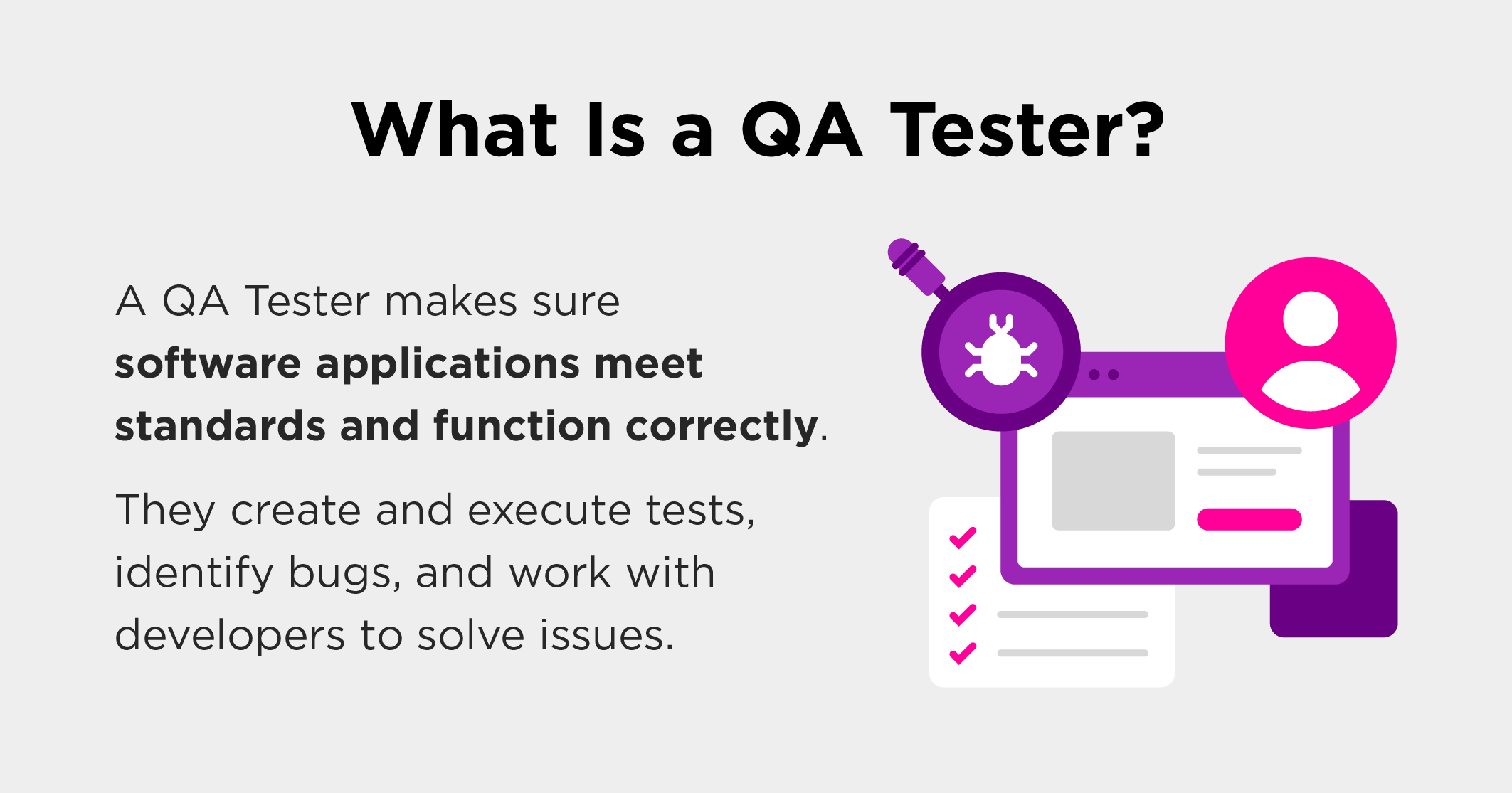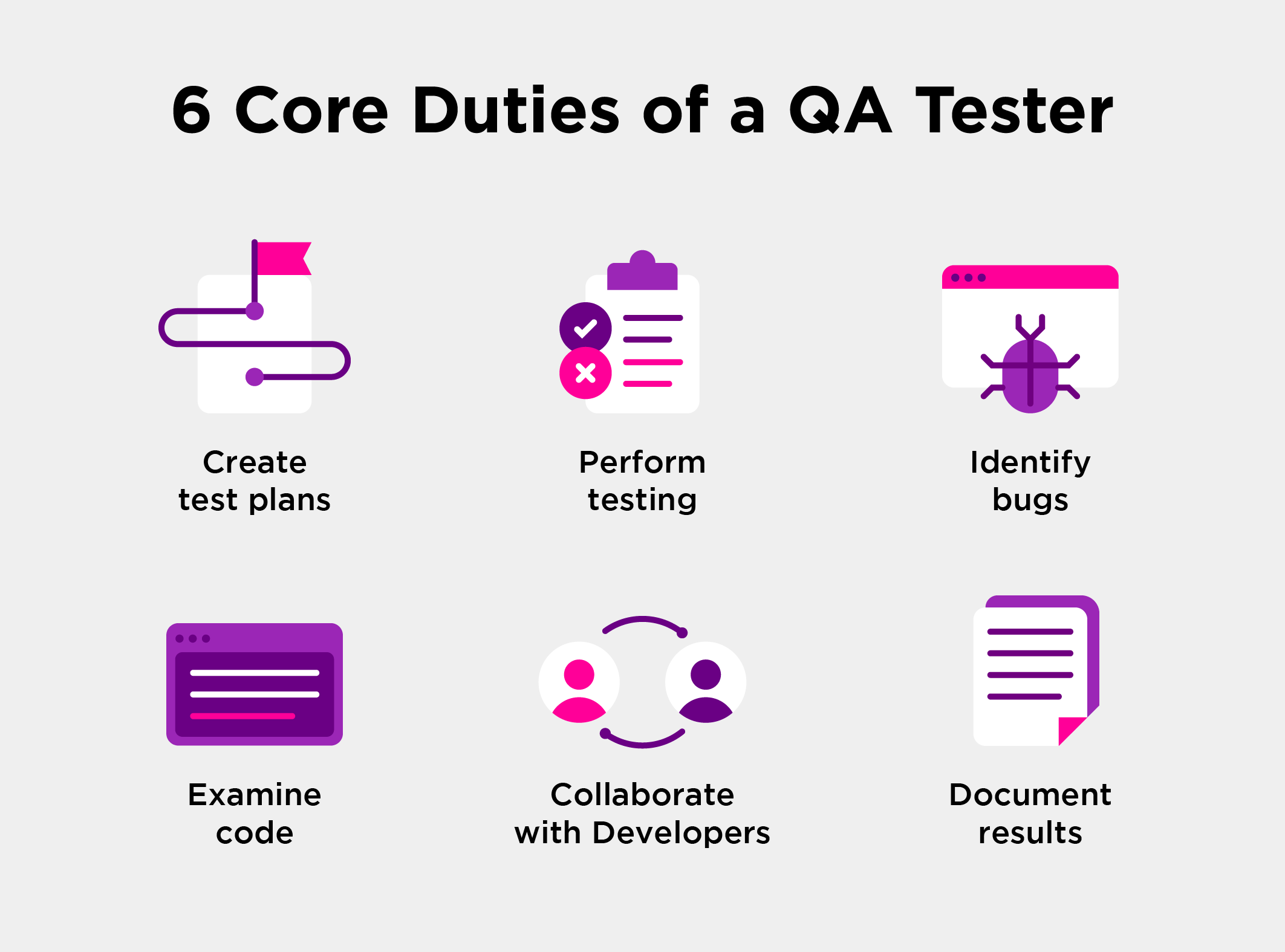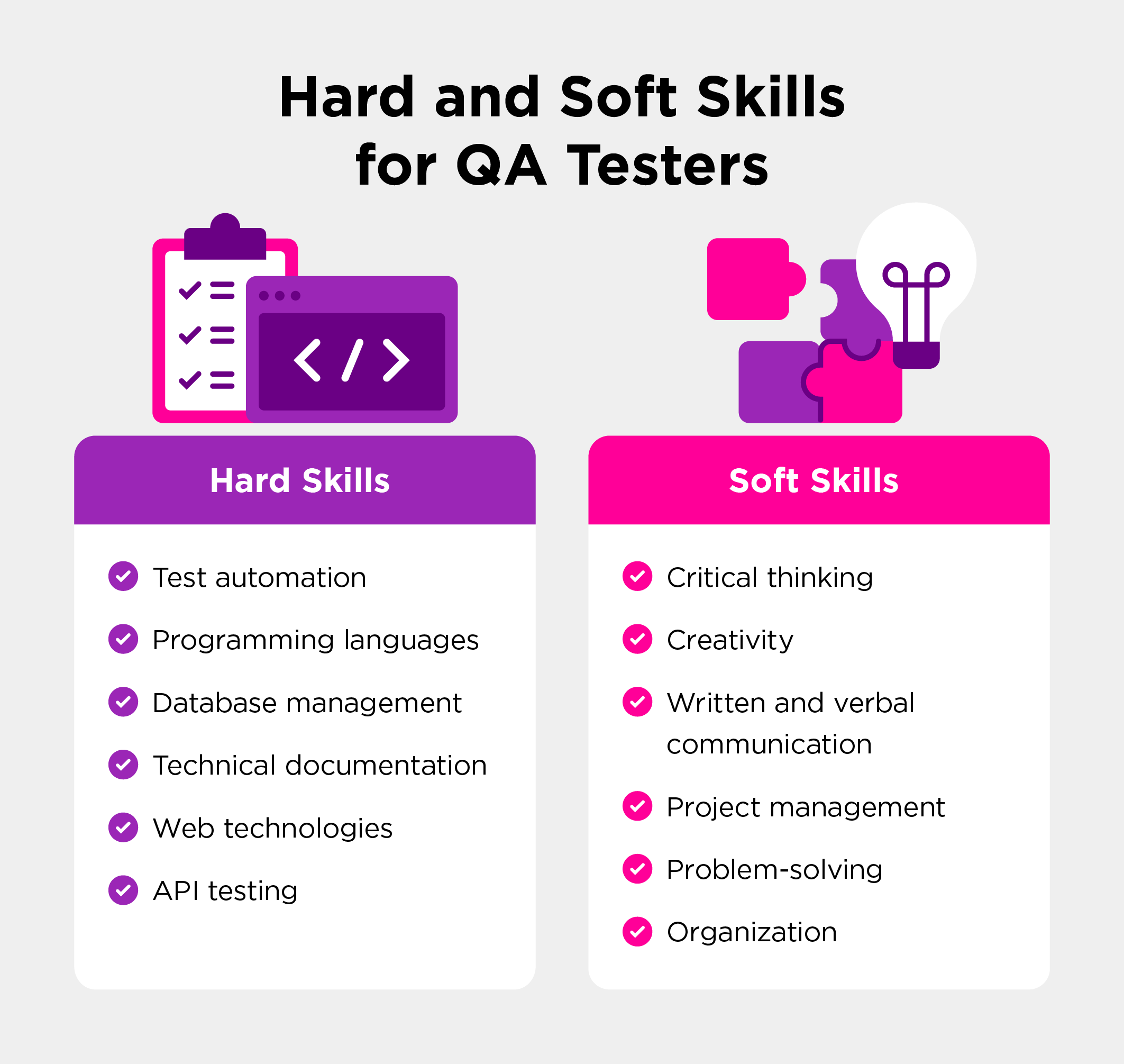What Is a QA Tester? Job Duties, Skills, + Salaries in 2024

quick answer
A Quality Assurance (QA) Tester evaluates software applications to ensure they meet quality standards and function correctly. They create and execute tests, identify bugs, and collaborate with developers to solve issues.
In This Article
Do you enjoy problem-solving? Are you naturally proficient with technology? In Canada’s growing tech landscape, the job demand in Canada for QA Testers is on the rise.
QA Testers play a vital role in the software development lifecycle by making sure applications meet the desired quality standards before they’re released to end users. This discipline has evolved alongside the growth of the information technology industry, becoming increasingly essential as software becomes more complex and relevant in our daily lives.
Keep reading for a complete guide to launching a career in QA testing, covering everything from essential skills to job prospects. Whether you’re considering a career switch or advancing your QA career, here’s what you need to know.

QA Testers work closely with Developers, Project Managers, and other stakeholders to identify potential problems early in the development process, helping save time and resources by preventing costly errors later on.
Their work involves a combination of technical expertise, critical thinking, and attention to detail to assess software performance, functionality, and user experience. QA Testers have various responsibilities, including:

QA testing encompasses various methodologies essential for ensuring software reliability and functionality. These testing types address different aspects of software quality, including functionality, usability, and post-release stability, collectively contributing to the delivery of high-quality software.
Unit testing verifies that small, isolated pieces of code are working correctly, often with automated tests. This helps identify bugs and errors early on for faster debugging and reduces the risk of regressions (when previously resolved issues reappear).
Additionally, it documents the behavior of code units, aiding in code maintenance and refactoring efforts (making improvements to the internal structure of code without changing its external behavior).
Also known as I&T, integration testing combines individual components or modules and tests them as a group to ensure they function correctly. This testing phase verifies the interactions and interfaces between different software parts, detecting any errors that may arise during integration.
Integration testing uses dummy programs that fill in for missing modules and simulate data communication for testing purposes. This helps validate the overall behavior and performance of the system, ensuring separate components work harmoniously as a whole.
This type of testing is a critical phase where the entire integrated system is evaluated to ensure it meets specified requirements and functions correctly in its intended environment.
It often involves a variety of test cases covering different scenarios and user interactions. This phase mitigates risks associated with errors in production environments and provides stakeholders with confidence that the software is ready for deployment.
Performance testing evaluates the responsiveness and reliability of a software solution. It tracks a system’s performance under expected and peak loads, identifies performance bottlenecks, and measures factors like response times and resource utilization.
QA Testers perform this type of testing by simulating realistic user scenarios, stressing the system to its limits, and monitoring its behavior under different load levels.
This testing phase ensures any recent code changes don’t break the software. It involves re-running previously executed test cases to verify that no new defects have been introduced and that the software still behaves as expected after making changes. Regression testing typically uses automated testing tools, and it ultimately helps maintain product quality throughout its lifecycle.
User acceptance testing (UAT) is the final phase of the software testing process, where end users evaluate the software to determine whether it meets their needs and expectations. It allows users to interact with the software as they would in their daily lives.
This can look like predefined test cases or letting users explore the system freely to uncover issues. This testing validates that the software is easy to use and delivers tangible value to the user.
Mobile testing is a specialized form of software testing focused on the functionality, performance, and usability of mobile applications across different devices, operating systems, and network conditions.
This testing is essential since so many people now use mobile devices. It can be performed manually or using automated testing tools and frameworks tailored for mobile platforms.
QA Testers require a diverse skill set to ensure the reliability of software products. Beyond a strong foundation in software testing principles, they need to possess other technical proficiencies and soft skills.
To ensure QA Testers can meticulously assess software functionality and deliver high-quality products to end users, they need a variety of technical skills under their belts. Here’s a list of key hard skills every QA Tester should have.
In addition to technical skills, aspiring QA Testers should have a diverse set of soft skills to excel in the field. Lean into your greatest strengths and keep this list of soft skills in mind:

With Canada’s current tech boom contributing to significant demand for skilled professionals, establishing a career in QA testing presents promising opportunities.
Current projections estimate there will be 143,700 new Information Systems Analyst and Consultant jobs by 2031. Demand varies slightly by province, with Manitoba, Quebec, and Nova Scotia predicting the most job prospects in the next three years.
While salary will vary depending on location and company, here are some average salaries for a QA Tester in Canada.

QA Testers have a wide range of career opportunities available to them. Here are a few positions that offer career growth and advancement in the software QA industry, including their responsibilities and average salary in Canada, according to Glassdoor.
| Types of QA Tester Jobs | ||
|---|---|---|
| Role | Core Responsibilities | Average Hourly Wage |
| QA Engineer |
|
$35.10 |
| Test Manager |
|
$46.15 |
| Test Engineer |
|
$34.13 |
| Test Analyst |
|
$46.98 |
| Test Automation Engineer |
|
$34.46 |
While the journey of becoming a QA Tester may vary depending on individual circumstances like prior experience and background, aspiring QA Testers can expect to spend a minimum of several months to a year acquiring the necessary skills and experience to enter the field. Here’s a step-by-step guide to starting a career as a QA Tester.
To become a QA Tester, you’ll need a college Certificate or Diploma. For example, a QA testing program can help you gain the knowledge and experience you need to land an entry-level position.
Additionally, gaining real-world experience through internships or co-op programs in software development or quality assurance can provide practical exposure to testing methodologies, tools, and industry best practices.
Some advanced QA Tester positions may require post-secondary education, like a Bachelor’s Degree in a relevant field, such as computer science, information technology, or engineering. Advanced Degrees, while usually not required, can offer specialized coursework and research opportunities in areas like software testing theory, test automation, and quality management.
Post-graduate Certificates and professional certifications can provide focused training in specific QA testing tools, techniques, and best practices. These certifications can help enhance your overall qualifications and marketability in the field.
To succeed in software quality assurance, you need to be familiar with various testing models that guide the development process and influence testing strategies. Critical testing models include:
The final step in pursuing a QA Tester career is applying for positions and preparing for interviews. This process includes:
Still trying to figure out if being a QA Tester is for you? Here are answers to the most common questions about the profession.
Yes, QA Tester jobs are in demand in Canada. It’s estimated that there will be around 143,700 new job openings in the field by 2031.
QA in testing refers to quality assurance, which is a set of processes and activities aimed at making sure software solutions meet defined standards and user requirements.
The difficulty of a QA Tester job can depend on factors like the complexity of the software being tested, the QA processes in place, and the individual’s skill level. While it can require meticulous attention to detail and a solid understanding of software systems, it’s not inherently harder than many other professions but demands specific skills.
As you plan a career as a QA Tester, consider the invaluable experience and knowledge that a specialized Software Tester program could offer. This online program offers training in programming, software development models, and testing foundations.
Apply now to advance your QA career today!
In This Article
Once you take the first step, one of our Student Admissions Advisors will get in touch to better understand your goals for the future.
Apply Now